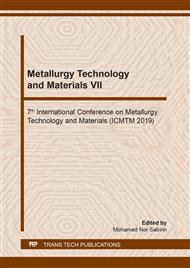p.52
p.59
p.64
p.69
p.75
p.83
p.89
p.94
p.100
Wear Resistance of Steels after Diffusion Saturation of Boron, Chrome and Titanium
Abstract:
In this work, the wear resistance of hardened simultaneous diffusion saturation on S235J0, C45, 55NiCrMoV6, C80W1 and X162CrMoV12 steels with boron, chromium and titanium and rigidly fixed abrasive Al2O3 particles were investigated. Wear was determined by measuring the loss of mass every 30 seconds of the test. Full wear of the layer occurred in 10 minutes with a load on the sample of 9.5 MPa. According to the test results, it is found that the wear resistance of alloyed steels increases as the content of alloying elements and carbon increases, but this increase is not unambiguous because of a decrease in the thickness of the diffusion layer as the degree amplification of alloying steels. Taking into account the economic parameters, such as the cost of steel, the cost of manufacturing products, we can conclude that the greatest economic effect shape can be achieved when using the hardening steels with a carbon content of 0.5 mass percent and the total content of alloying elements up to 5 - 7 mass percent.
Info:
Periodical:
Pages:
75-80
Citation:
Online since:
October 2019
Keywords:
Price:
Сopyright:
© 2019 Trans Tech Publications Ltd. All Rights Reserved
Share:
Citation:


